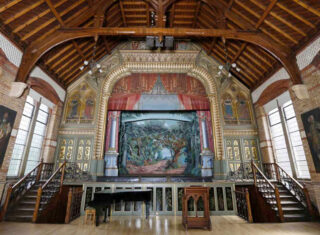Adam and Eve. In the manner of William Morris and Walter Crane. Circa 1880-1900. Arts and Crafts Needlework of large proportions.
Though having elements of William Morris and Walter Crane, it has not been possible to validate the designer and further research is required. (see technical report below). Although the work could not be attributed to the aforementioned, it has not been ruled out by leading experts. No records exist to confirm the origin.
Provenance: This would have been a very expensive commission for a wealthy family or organisation. The work spent its earlier life in the White Highlands of Kenya. It was then sold at an estate auction in the 1960s where purchased by he current vendor.
Technical Report:
An embroidered wall hanging measuring 8 foot x5 foot depicting Adam and Eve amidst exotic birds and animals. The surface fabric is a ribbed plain weave (low ‘S’ twist yarn) (generally referred to as repp, but this specific fabric could be a grosgrain) it has a fine but pronounced, even rib running horizontally across it, most likely made from linen (or other natural fibre blend) due to its sheen in certain lights.
The piece is likely to have been produced by an embroidery school and is undoubtedly the work of highly skilled embroiderers; this is evident by the techniques and execution. Embroidery establishments were common up and down the country, and indeed, across Europe. The School of Art Needlework Est. 1872 now the Royal School of Needlework, was one such place, which would have worked on commissions for private clients and designers.
The embroidered motifs, including the animals and figures are worked in naturally dyed wools, using long and short stitch aka “painting with a needle” to create a naturalistic finish, with several rows of split stich to create a border around each; finer details such as eyes, nose, and whiskers on the tiger and facial features on Adam and Eve for example, have been put in using a fine cotton thread. The birds have been embroidered using a silk floss and feature bright colours including greens, blues, yellows, and silver. Couched Japanese thread (a metal foil wrapped around a thread core) has been used on the peacock feathers. Further couching, of brown wool, can be found in the geometric border pattern around the edges.
The entire piece is bordered with a gold thread woven trim.
Animals depicted include tigers, caracals, deer, frogs/toads, several different species of birds including pelicans and peacocks, set in and amongst acanthus leaves.
The RSN have no records of their works and commissions prior to the 1930s and therefore they can not ascertain if this piece was created by them, nor are they able to confirm if the piece could be linked to Morris, Burne-Jones, Crane, et al, despite the fact that such designers did commission the school to complete works for them.
Although the Acanthus leaves echo William Morris circa 1885, other design elements resonate with Walter Crane.
Further research in to the figures is advised as they have a pre raphaelites influence.. Also further research in to the biblical quotes would be advised and could have links to stained glass window designs.
Contact Rik Alexander for further info, video viewing or if you can share further information on the work.
[email protected]
Realised Price: £No Entry
{CUST_LABEL_ARTIST_NAME}:
{CUST_FIELD_ARTIST_NAME}
{CUST_LABEL_SCULPTURE_DESCRIPTION}:
{CUST_FIELD_SCULPTURE_DESCRIPTION}
{CUST_LABEL_ARTIST_INTRODUCTION}:
{CUST_FIELD_ARTIST_INTRODUCTION}




